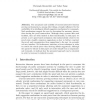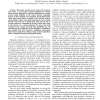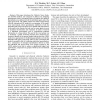170 search results - page 26 / 34 » Measuring Agent Intelligence via Hierarchies of Environments |
AAAI
2006
13 years 9 months ago
2006
Following verbal route instructions requires knowledge of language, space, action and perception. We present MARCO, an agent that follows free-form, natural language route instruc...
AIMSA
1998
Springer
13 years 12 months ago
1998
Springer
The acceptance and usability of current interactive theorem proving environments is, among other things, strongly influenced by the availability of an intelligent default suggestio...
TSP
2010
13 years 2 months ago
2010
Abstract-- This paper presents greedy gossip with eavesdropping (GGE), a new average consensus algorithm for wireless sensor network applications. Consensus algorithms have recentl...
ESAW
2009
Springer
14 years 2 months ago
2009
Springer
Expressing contractual agreements electronically potentially allows agents to automatically perform functions surrounding contract use: establishment, fulfilment, renegotiation et...
CEC
2007
IEEE
14 years 2 months ago
2007
IEEE
Abstract— This paper introduces the Collective Neuro Evolution (CONE) method, and compares its efficacy for designing specialization, with a conventional Neuro-Evolution (NE) me...



